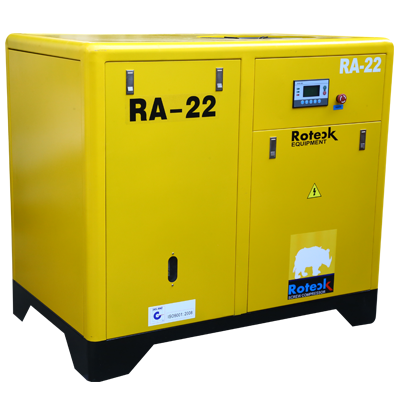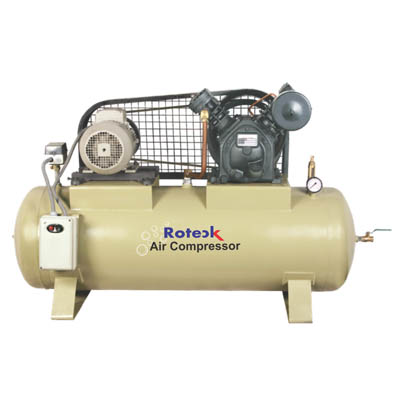Rotary Compressor is a mechanical device which is used for delivering a large quantity of air up to the pressure of 10 bars with continuous flow. Reciprocating compressors and Screw compressors are two of the most popular compressor technologies available today. Rotary screw air compressor available, low cost of ownership, uptime warranty,on-time delivery and quick customer support.

What factors should I consider?
Duty Cycle, Energy efficiency and service intervals are very important factors to consider when determining whether your business will get more benefits from a rotary screw air compressor or from a reciprocating (piston) compressors.
In the same way, Rotary compressors are the most popular or well-known type of screw compressors which uses a rotary- type positive displacement mechanism. Rotary compressors are very much common in industries and have replaced reciprocating compressors where compressed gases are needed in a large number such as for a large refrigeration cycle or for air systems to operate tools like jackhammers and impact wrenches.
Rotary Screw Air Compressor
In Rotary screw air compressor, the most important part is the screw unit. When compressor starts running firstly, it raises the compressors inside pressure approximately 1-2 bars.
Did You Know?
Generally, Rotary Screw technology is the same technology utilized by superchargers in high-performance engine.
How Does a Rotary compressor (Screw Air) work?
The Principal behind a Rotary screw compressor was created in the 1930’s. The twin components of the air compressor incorporate male and female parts turning in inverse ways. Air occupies the space between the rotors and, as they pivot, the volume among them and the encompassing lodging diminishes, crushing or compacting the air into a more modest space,the length, pitch of the screw, and the type of the release port on the whole decide the pressing factor proportion. Past that, there are no valves, or other mechanical powers that can cause unbalance, which permits a screw blower to work at high velocities while joining an enormous stream rate with little outside measurements – it sneaks up all of a sudden for its size.

- Root Blower –
- In fact, Root blower compressor is a positive displacement compressor, which is easy to operate just by pumping a fluid with a pair of lobes.
- The pumped fluid is trapped in pockets that are surrounded by lobes and carried to the exhaust.
- Applications– You can easily find root blower compressors in industry and industrial processes such as pneumatic conveying, industrial vacuum cleaning, and dust filtering systems.
- hence, It also helps in measuring the flow of gases and liquids in reverse such as in gas meters.
- Scroll Compressor –
- Further, A scroll compressor is a specially designed compressor that works in circular kinetics, as opposed to up-and-down piston action.
- It has one fine-tuned scroll which remains at rest and another moving or orbiting scroll that rotates through the utilization of a swing link.
- Application- Used in air conditioning equipment, like automobile supercharger, and as a vacuum pump.
- Screw Compressor –
- Screw- rotary compressors are well known for their efficiency in low air pressure requirements nowadays.
- When two screws rotate, it traps the air between the screws which forms pockets that gradually travel and get squeezed which creates a higher pressure and opens the delivery valves.
- The compressed air delivery is quite continuous as compared to the reciprocating compressor.
- Application- Commonly used in processing gas, refrigeration, and natural gas applications, which includes individual wellhead boosters, low- pressure gathering systems, fuel gas compression, solution gas, and vapour recovery compression systems.
- Vane Type –
- In short, Vane Compressors are one of the most widely used products in today’s world. They accommodate a wide range of industries.
- Vane Compressor used centrifugal kinetics to create compressed air.
- Vane compressors are generally utilized for capacities up to 150- meter cube/min and for pressure ratio up to 8:5.
- Application- They serve a wide range of industries like in agriculture for operating farm equipment, material conveying, in the auto body paint shop for paint pump operation, in tire and wheel shop for tire inflation, in welding operations, and air-operated metal and woodworking tools.
Now the big question arrives that how Rotary compressor works or on what principle it works?
•In summary, Rotary-screw compressors use two screws, known as rotors, to compress the gas. In a dry-running rotary compressor, timing gears that the male and female rotors maintain precise alignment without contact would create expeditious wear.
• In an oil-flooded rotary compressor, lubricating oil maintains the space between the rotors, by providing a hydraulic seal and transferring mechanical energy, which allows one rotor to be completely driven by the other one.
•Further, Gas enters at the suction side and moves through the threads due to screw rotation. The gas is forced through the compressor by the meshing rotors and the gas exits.
•The working area is the inter-lobe volume between the rotors. It is much large in space at the intake end and decreases along the length of the rotors until the exhaust port. This transmutation in volume is the compression. At the end of the rotors, the intake charge is drawn in the large clearance between the male and female lobes.
•At the intake end the male lobe is much smaller in size than the female lobe, but the relative sizes reverse proportions along the lengths of both rotors until the clearance space between each pair of lobes becomes smaller.
• However, this minimization in volume causes compression of the charge a fore being presented to the output manifold. The efficacy of this is dependent on the proper fitting of clearances between the helical rotors and the rotors. However, some leakage is inevitable, and high rotational speeds must be habituated to minimize the ratio of leakage flow rate over the efficacious flow rate.
•In contrast to Roots blowers, modern screw compressors are made with: the male rotor has convex lobes and the female rotor has concave cavities. The male rotor rotates faster due to its few lobes as compared to the female one. Originally, screw compressors were designed with an asymmetrical rotor cavity, but modern versions use asymmetrical rotors.
Rotary compressor– lubricated or oil- free?
Oil-free
- In Brief, Oil-free rotary screw models are utilized in industrial, engendered, or medical applications when no oil can enter the airflow, like for aliment packaging or medical oxygen. Oil-free rotary air compressors are more sumptuous, as they require 2 stages of compression to reach the same pressures as an oil-injected rotary system. Most companies only utilize oil-free rotary screw air compressors when they absolutely need to so oil-free air compressors aren’t customarily found on conveyances.
Lubricated
- In short, Rotary compressors utilized on trucks and vans are oil-injected, which designates oil is utilized to lubricate and seal the rotors in the air-end. This sanctions the rotors to engender high pressures quite expeditiously and compress air in a single stage. The oil then gets dissevered from the air before the air exits the system and is recycled back into the air-end for reuse. Oil-injected rotary screws sanction the compressor systems to provide high CFM and PSI perpetually.

A Brief comparison between the oil-free and lubricated rotary compressor
| Oil-free Rotary Compressor | Lubricated Rotary Compressor |
| Oil-free Rotary compressor is generally a lighter unit. | Lubricated Rotary Compressor are more durable. |
| In this Rotary screw compressor, less maintenance is required. | In this Rotary screw compressor, more maintenance is required. |
| This rotary screw compressor is equipped with permanent lubrication. | In this rotary compressor, Oil injection is compulsory. |
| This rotary compressor is less expensive. | This rotary air compressor is slightly expensive. |
| This rotary compressor is having lower performance. | This rotary compressor is having a longer lifespan and higher performance. |
Application of Rotary Screw Compressor –
- Automotive industry
- Biogas plants
- Chemical and petrochemical industry
- Chip manufacturing
- Industrial gas manufacturing
- laboratory and research facilities
- Food industry
- Hydrogen filling stations
Difference between Rotary Compressors and Reciprocating Compressors
| Rotary compressor | Reciprocating Compressor |
| In Rotary compressor,due to the rotary motion of blades, the compressor of air takes place. | In Reciprocating compressor,compression of air takes place with the help of piston and cylinder with the reciprocating motion. |
| There is continuous delievery of air in rotary screw compressor. | Delivery of air is intermittent in a reciprocating compressor. |
| The flow rate of air is high in rotary screw air compressor. | The flow rate of air is low in a reciprocating compressor. |
| It needs proper lubrication and more maintenance,because it has more moving parts. | It needs less maintenance. |
How to choose the right size of the rotary compressor?
Above all, Rotary screw air compressors are replacing reciprocating models in the industrial sector due to their unique design features. In a reciprocating air compressor, the air gets sucked through an inlet valve into a cylinder, then constricted through a dyad of counter-turning helical screws. You can then utilize the incipiently pressurized air for sundry pneumatic implements and applications, such as nailing, screwing, cutting, sanding, drying, painting, and searing.
In brief, If you’re wondering how to cull a rotary screw compressor for your operations, you should consider that they contain fewer moving components, and consequently make little noise and engender less heat during obligation cycles. Thanks to the relative simplicity of their design, rotary screw air compressors require less maintenance and generally offer superior accommodation life. Rotary compressors are available in portable and stationary varieties suited for a range of personal and industrial uses.

Good Informative content..
Thank You!!